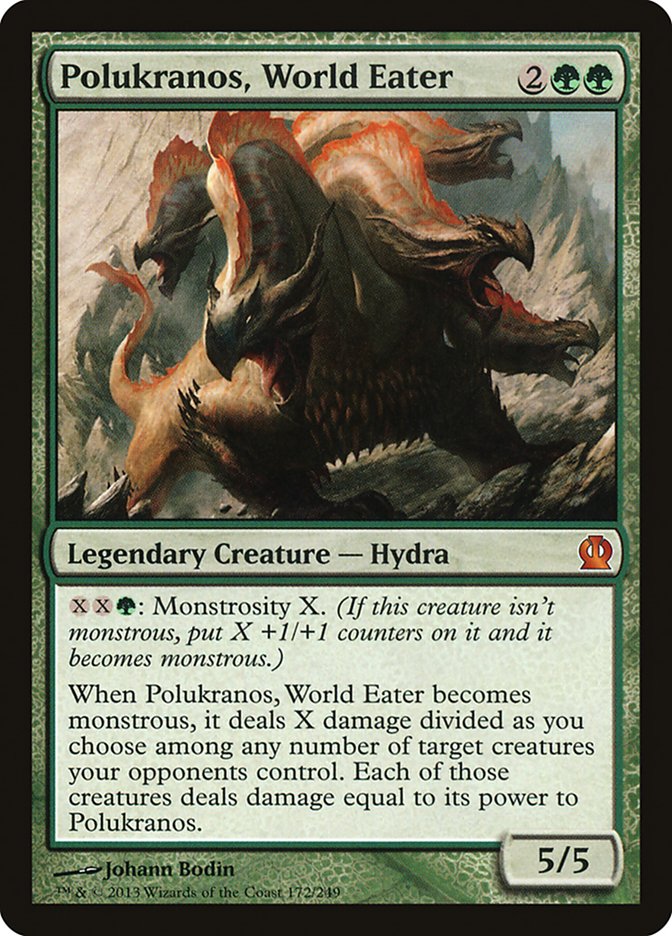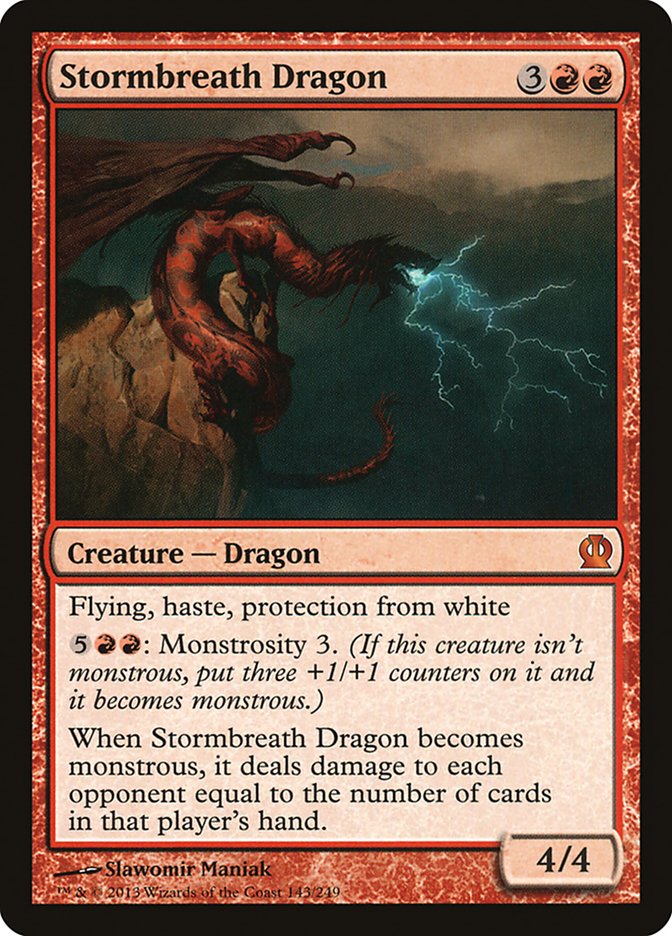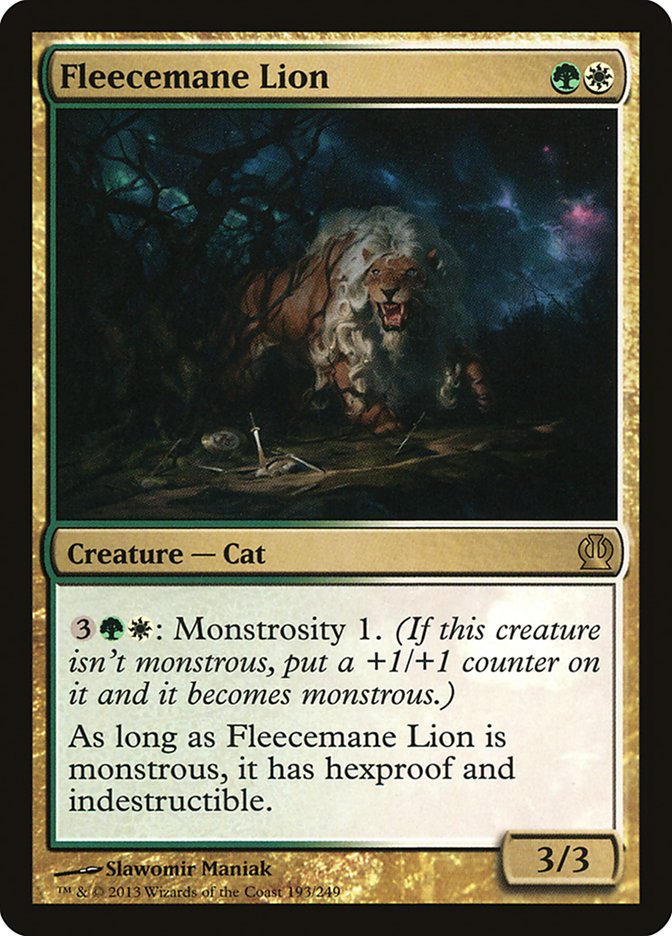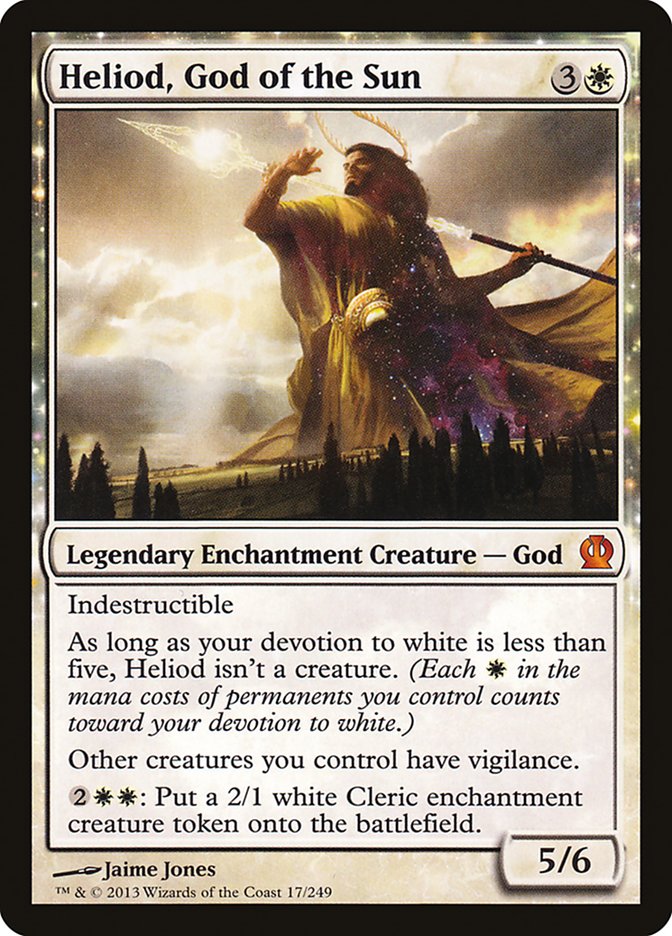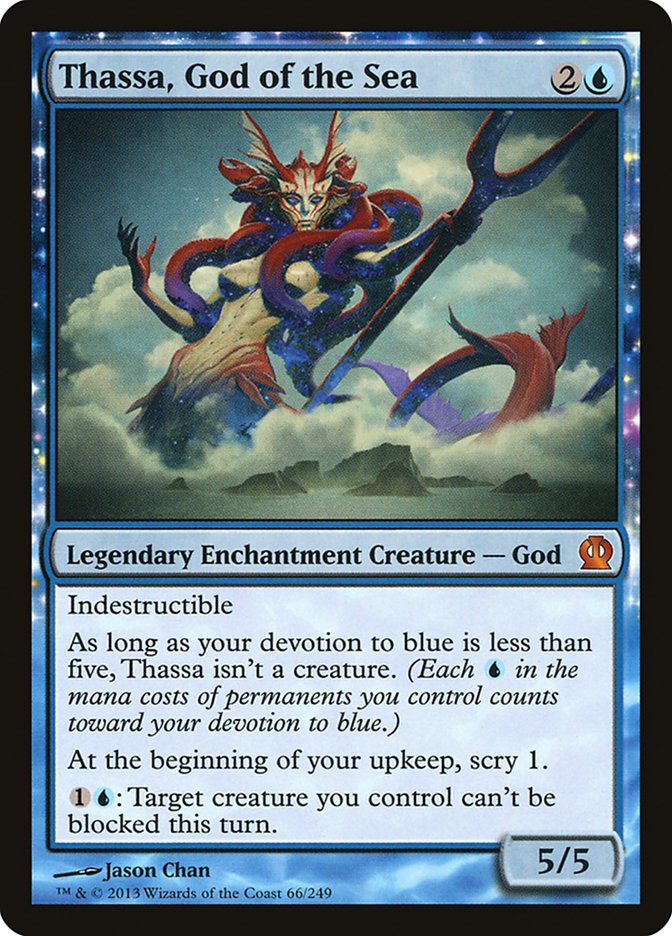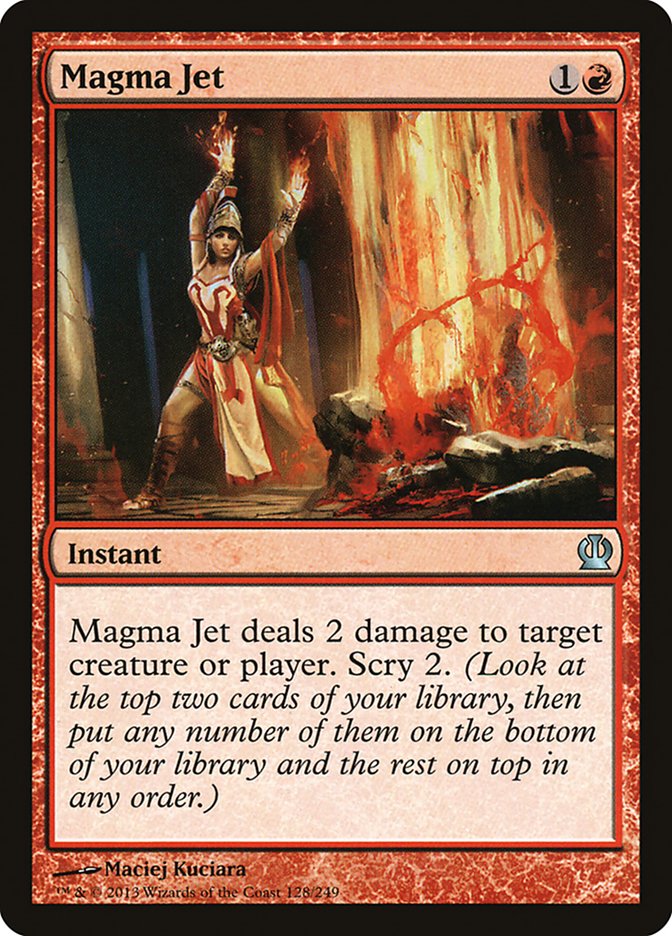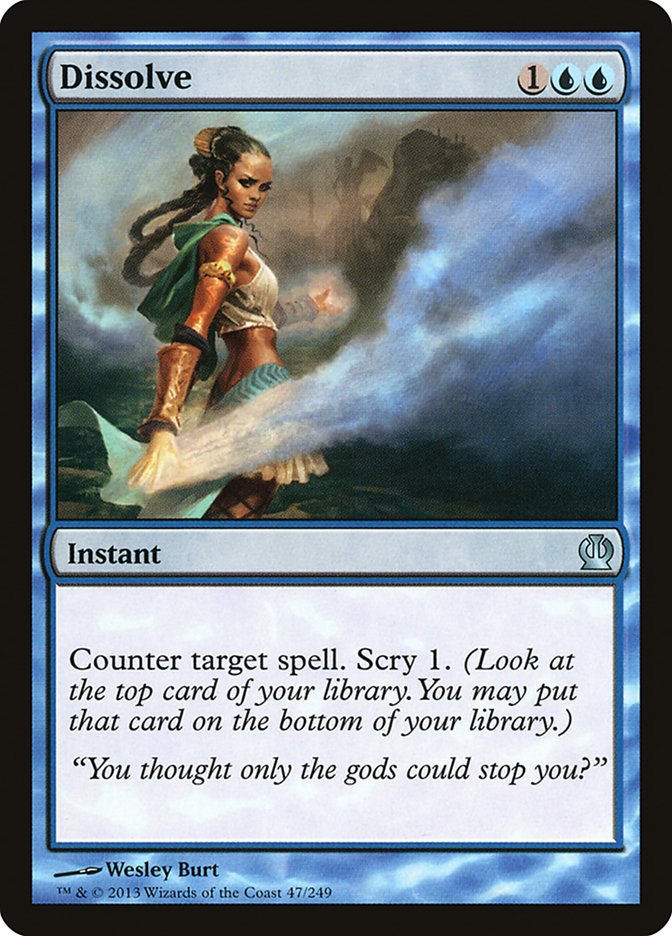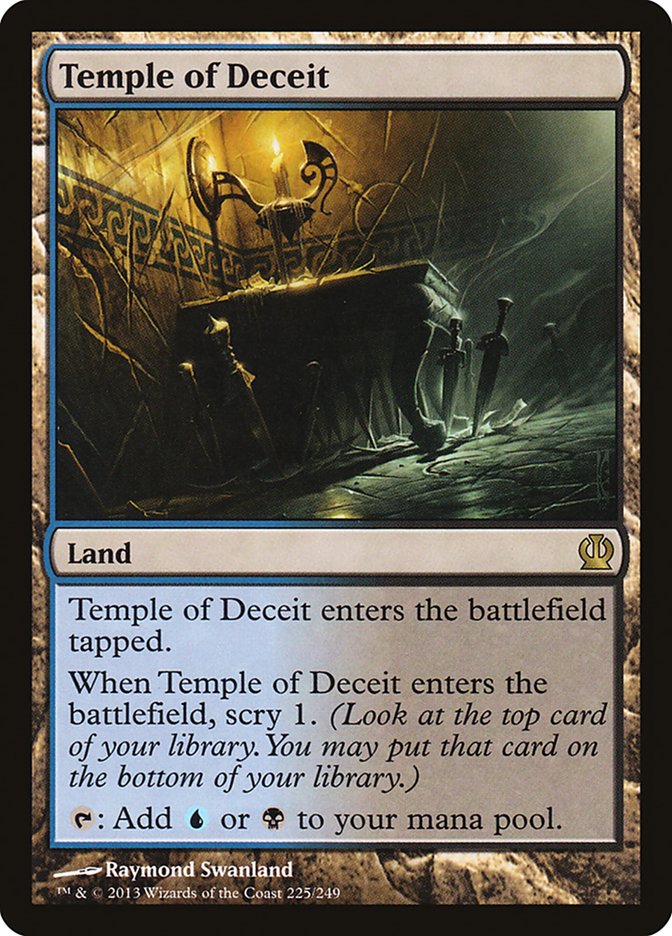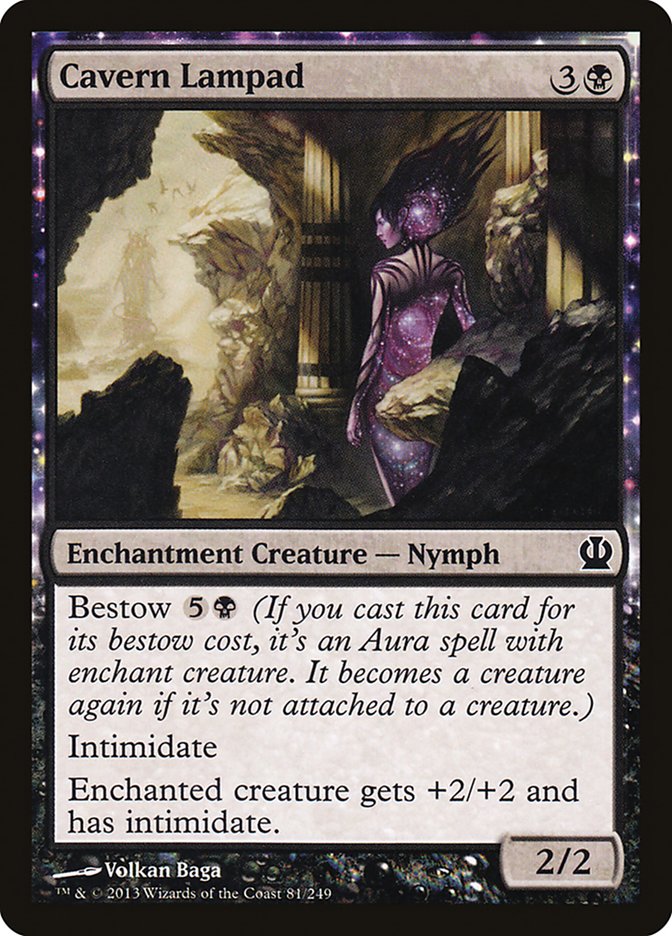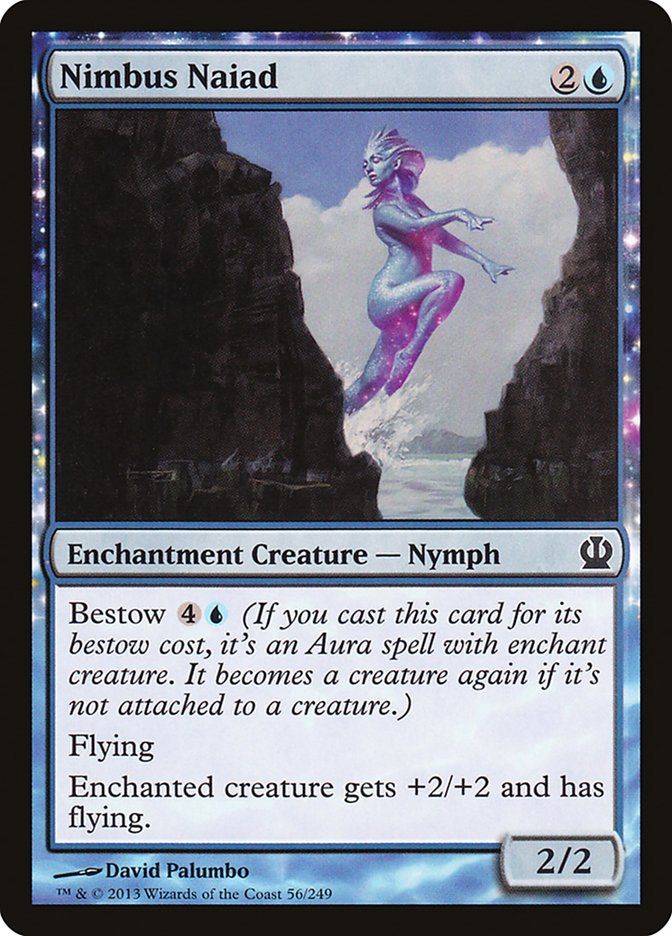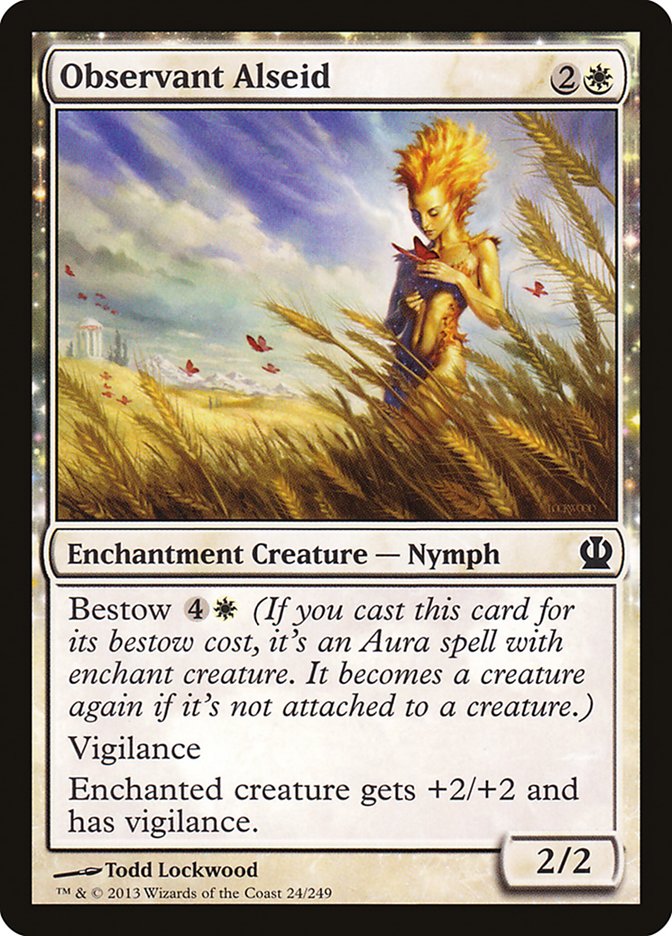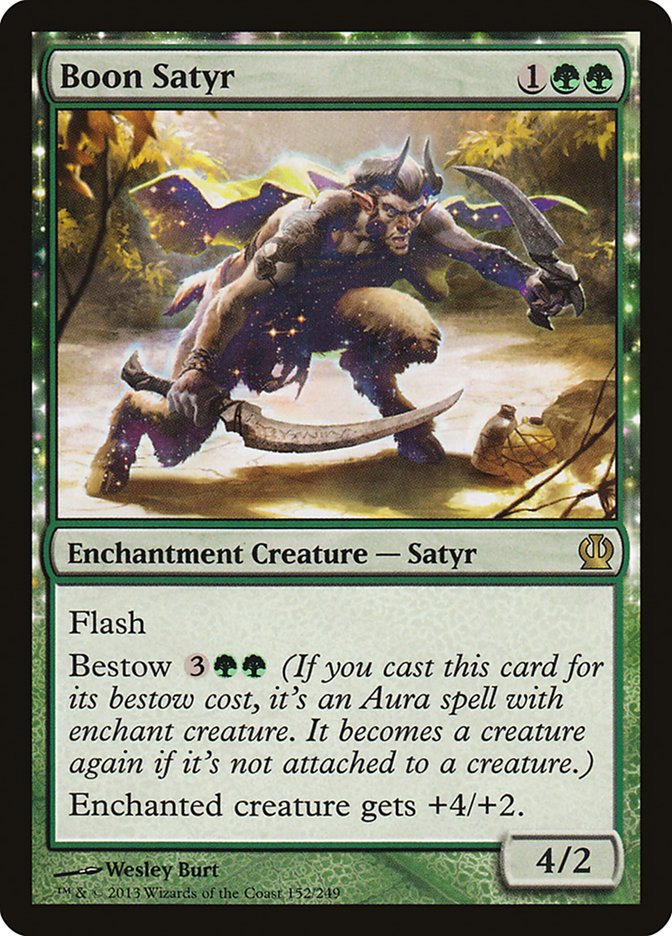Whenever a new mechanic comes out, I try to ask myself, "Which cards did R&D push to make sure the mechanic shows up in Constructed?" Some mechanics lend themselves better to Constructed than others, but in general R&D tries to make sure every mechanic shows up on at least a few cards, so the mechanics that don’t look naturally good for Constructed require special attention to make sure we find the ones that were pushed.
There’s no shortage of good monstrosity creatures.
Devotion is looking pretty good too.
Scry is definitely covered.
That leaves us bestow and heroic. Both are tied into wanting to target your own creatures (and Auras in general), which is usually a bit worse in Constructed than Limited. Finding the "pushed for Constructed" editions of each of these mechanics is going to be a key component of the new format and being ahead of the curve at identifying what’s good in the new world.
We already touched on heroic a little bit last week, although we are still on the hunt for a truly over-the-top enabler or heroic card. There are some good ones, to be sure, but finding good ways to target your own creatures is going to be a little bit of a trick. I actually want to experiment with Flames of the Firebrand, as the possibility of dealing two to an opponent and one to your hero or possibly even just one to each of your three heroes is pretty appealing.
Today, however, I’d like to take a look at the relatively neglected bestow mechanic. Bestow is tailor made for Limited, where not only are Auras typically better than they would be in constructed but you have extra time and wasted mana to take advantage of the virtual card advantage gained when you use a bestow ability.
Bestow is a sort of kicker where if you pay the kicker, you will get both the Aura and the body (after the creature you put the Aura on dies). That is really cool and definitely going to be a lot of fun; however, what it is not is inherently good in Constructed. Looking at the various bestow creatures, it’s pretty clear that tons of them are going to just rock in Limited, like Cavern Lampad, Nimbus Naiad, and Observant Alseid:
Of course, those are all part of a common cycle. The key to finding good bestow cards? My guess is that they will either be so sick a rate on the body that you’d play it even if it didn’t have bestow or just a sweet Aura (when viewed as a cantrip) and a not embarrassing body naturally. A key clue to look for is odd, relatively unique characteristics. Whenever a new mechanic doesn’t naturally look that good in Constructed, it is a classic R&D move to either staple it to a body no one could hate (Fleecemane Lion) or to put it on a card that has novel elements to it so that people can decide they like it regardless of the cost, helping disguise the fact they don’t actually know how to evaluate the power/cost ratio (Purphoros).
Looking at the cards previewed from Theros, there is at least one Bestow card that really jumps out at me.
This card qualifies as both confusing power level (unusual stats, particularly on a flash creature) and reasonable rate on its own (four power on a three-drop, with three or four different forms of upside).
Before breaking down all of the upsides, it can be useful to know how far we have to go to justify the card. How good do these abilities have to be? How good is a 4/2 creature for three mana?
The closest comparison is Wolfir Avenger, which saw regular tournament play though was not a dominating force. How do they compare? Generally, I’d say a 4/2 and a 3/3 are fairly comparable in terms of the value of the body. Power is generally very slightly better than toughness; however, the third point of toughness has extra meaning on a flash creature. What is more likely to matter? Dealing four damage as a surprise to a four-toughness attacker (that the Avenger wouldn’t have killed), or killing a 2/2 and living (which the Satyr does not do)?
The next place where they diverge is Wolfir Avenger’s 1G: Regenerate versus Boon Satyr’s bestow ability. Both of these abilities are hard to quantify exactly, which is part of what makes both of these such interesting cards. Wolfir Avenger would have been passable without regeneration but not exciting. It’s almost as though the amount it is good is how much you value the regeneration ability. I wouldn’t have paid a full colorless mana for it, but it probably is worth at least a full point of toughness, as a 3/4 flash would be at least comparable to the Avenger.
As for Boon Satyr, how much should we value the "kicker" ability? Most bestow creatures have two modes. You can play them as a creature or pay extra to get a "haste creature" in the form of an Aura that later "draws you a card" by giving you a creature when the first dies.
Boon Satyr has three.
You get the same two options, 1GG 4/2 fast creature or 3GG "4/2 haste creature (with utility of modifying another creature) that draws and plays a 4/2 creature when that creature dies," but you also get a combat trick mode. When you bestow at instant speed, you can spend 3GG to give a creature +4/+2 (which is often going to be worth a card). Then you get to keep the +4/+2 bonus, which is worth at least a full card (and generally more), and when that creature dies, you get a 4/2 creature in play (which is worth more than a card, but you do have to wait).
Add all of this together and we find that using Boon Satyr as an instant is generally going to be better than a three-for-one whenever you are able to get a card of value out of the instant speed pump! That is pretty fantastic, but what makes the card particularly exciting is that Boon Satyr isn’t a Jace’s Ingenuity but rather a Mulldrifter. That is to say that we are not just locked into a five-mana three-for-one but rather can buy a five-mana three-for-one that includes a board presence that adds up to more than three cards’ worth of value and we have the option to buy a reasonable card at three mana (Divination versus a worse Wolfir Avenger).
Now, when short on mana, I’d rather have Divination than a 4/2 fast creature, and card draw attached to a body is much easier to make good than a pump spell attached to an Aura attached to a body. Ok, fair enough; Boon Satyr isn’t as good as Mulldrifter, but it does have a little more power when you can actually make it work completely.
Of course, Mulldrifter isn’t the curve, and Boon Satyr has a couple other features. To begin with, it is an enchantment. If you don’t capitalize on this at all, it is a minor drawback (as your creature can be Naturalized), but there are a lot of ways to potentially take advantage of it, such as Ajani’s Chosen, Auramancer, Commune with Gods, Ethereal Armor, and Sphere of Safety.
Additionally, that it is fast with such sideways stats has some cool applications for evolve . . .
Which brings us to:
Creatures (36)
- 3 Scavenging Ooze
- 4 Cloudfin Raptor
- 4 Experiment One
- 4 Gyre Sage
- 4 Shambleshark
- 4 Vorel of the Hull Clade
- 3 Renegade Krasis
- 4 Kalonian Hydra
- 3 Polukranos, World Eater
- 3 Boon Satyr
Lands (25)

Yes, it’s 61 at the moment. A lot of brews start this way when you aren’t yet sure of things like "do you want 24 or 25 lands?" and "can we afford to a cut a two-drop, or do we need to cut a three-drop?" I think if I had to enter a tournament with this deck right now, I’d cut a Renegade Krasis, but I kind of want to learn more about how all of the different parts fit together.
This list features nineteen evolve creatures, so it gets a lot of mileage out of creatures with a big stat (such as Boon Satyr). Being able to pump evolve creatures at instant speed is actually pretty sick in a deck without any spells (so that you have tricks, ways to throw your opponent’s math off). That Boon Satyr is a trick itself is actually pretty sick. It is important to note that if you use it as an Aura, it won’t pump your evolve creatures; however, just casting it for three works.
So why go to the trouble of playing a bestow creature? Well, to start with, having your own Ghor-Clan Rampager can go a long way. We don’t always have five evolve creatures in play, and one big pump on a creature adds a different dimension than some small pumps. It’s also just more options. For instance, if your opponent is playing Supreme Verdict, having the ability to add four damage (with haste) and then still have a four-power attacker the turn after they cast Verdict can be huge.
Boon Satyr (unlike almost every Aura ever) actually increases our resilience to spot removal. While most Auras put you at risk of getting two-for-oned, bestow actually has a special set of rules made especially for it. If you target your creature with a bestow creature as an Aura and your opponent kills your creature in response, you still get the creature from bestow. Why? Frankly, I have no idea what the reason could be besides WotC just said that is the way it works, presumably to make bestow a little stronger/more fun. The reminder text certainly doesn’t clear things up.
Nevertheless, the rules are what they are, which is a point in favor of bestow creatures. This U/G Evolve deck is jam-packed with "Baneslayers" that require answers from your opponent. Boon Satyr lets another creature become a major threat or turns a big one into a game-ender. Even if your opponent comes up with an answer, you still get a nice, free follow-up play in the form of a four-power threat.
It’s not just creature kill that bestow has resilience against. Chained to the Rocks? Detention Sphere? Azorius Charm? As long the target creature stops being attached to the Aura, it will turn back into a creature.
Sample openings involving Boon Satyr for a surprise finish:
Turn 1: Experiment One
Turn 2: Shambleshark, take two
Turn 3: Boon Satyr, take six (with ten power showing).
Turn 1: Experiment One
Turn 2: Gyre Sage, take two
Turn 3: Renegade Krasis, take five
Turn 4: Boon Satyr, take thirteen
Of course, sweet evolve draws are nothing new, but the point is Boon Satyr provides some sweet lines of play that capitalize on its combination of stats and flashiness.
Each creature in this list provides some unique element, giving the deck a surprising amount of versatility for a mono-creature deck.
Experiment One and Cloudfin Raptor are obviously primarily about being one-cost evolve creatures; however, regeneration helps against sweepers and a few flying creatures can give us a way to finish off opponents that actually manage to slow down the ground, particularly when you give the Raptor +4/+2.
Shambleshark is an aggressive evolve creature, but it also gives you cheap instant speed triggers, making blocking decisions very tough.
Gyre Sage providing extra mana helps us get to Kalonian Hydra earlier, bestow Boon Satyr, and just set up some big turns where we play several cards in a row.
Scavenging Ooze grows on a different metric than your other cheap creatures, but it does trigger them all, gains you life, and disrupts people who abuse the graveyard. That it is gaining +1/+1 counters is actually super relevant because Vorel of the Hull Clade, Renegade Krasis, and Kalonian Hydra all pump anyone with +1/+1 counters from any source.
Vorel is actually a superstar and if unchecked quickly takes games in a silly direction. His stats are pretty unusual themselves, letting him evolve a lot of creatures, but his doubling ability really shines when targeting a creature with evasion (such as Cloudfin Raptor with flying or Kalonian Hydra with trample).
Renegade Krasis is pretty lame against removal, but part of the hope is that we have so many must-kill creatures that eventually our opponents will run out (which is a big part of the reason this deck follows the classic Zvi strategy of not using any totally reactive cards, instead packing as many threats as possible into the list). The Krasis is a +1/+1 counter lord of sorts and pays us off for playing so many creatures that get them.
Polukranos actually does a lot great things for us, and if he weren’t a legend, I would play four. Even as a legend, it is worth considering depending on how valuable it is to deal a few points of damage split up. A deck of all creatures definitely appreciates having some removal for particularly problematic creatures, and occasionally Gyre Sage is going to lead to some really big mana scenarios where Polukranos is going to get very, very big.
In addition to providing much-needed interaction and a great way to sink mana, Polukranos being a 5/5 base means he is basically always going to be evolving your creatures. Then, once he gets angry, he will have +1/+1 counters of his own, letting you Vorel, Renegade, or Kalonian Hydra them.
It’s worth noting that the new legend rule can be used to get you extra removal in certain corner cases. For instance, let’s say you already used Polukranos but your opponent is racing you with fliers (and has blockers for the World Eater). You can actually play a second Polukranos and get rid of the old one. The new one won’t be monstrous yet, meaning you can get another chance to activate the ability.
Kalonian Hydra is probably the most exciting creature in the deck, as it is not only an 8/8 trampler the first time it attacks but it nearly doubles the size of every creature you have in play. If you ever get to attack even once, that is usually game over. Normally the weakness of such a card would be things like Doom Blade, but are they not using Doom Blade on Cloudfin Raptor? Scavenging Ooze? Vorel? Polukranos? Not only is Kalonian Hydra the most insane Vorel ever, but it also works great with Vorel, who can make the Hydra a 16/16 or even 32/32 for his first attack.
The mana is definitely not a trivial puzzle to solve as well. We really don’t want to mess up our curve, so tapped lands aren’t super appealing. However, with just eight one-drops and lots of twos, we can probably get away with a couple scry lands. The mana was always the weakest spot of this deck in Block, though the Block version needed to be three colors to get enough power.
Speaking of playing three colors, might we want to splash black for Corpsejack Menace, Lotleth Troll, and possibly even Varolz? We probably wouldn’t want removal maindeck, but having black sideboard cards is definitely a nice feature. Given how hard mana is in the new format and how much raw power we already have, my guess is that U/G is the better approach.
Another possibility is to incorporate Elvish Mystic. We already have plenty of ways to cast it on turn 1; however, it doesn’t really help our evolve chain to spend a turn playing an accelerator. We want to play our three after a two that was played after a one. If we play an Elvish Mystic into a three-drop, we’re not even really doing that much. It might still be worth it, but the Mystic is far worse here than it would be most places.
Of course, U/G Evolve is hardly the only way to use Boon Satyr . . .
Creatures (24)
Lands (24)
Spells (12)

With the loss of Invisible Stalker, Geist of Saint Traft, and Rancor, this strategy is going to have to change a lot. This build has a lot of ways to dominate the ground and tries to create very heavy-hitting threats that can win a game on their own.
Maybe we should have some lifelink creatures (which combo very well with Boon Satyr). Maybe we should have some bigger plays (like Polukranos or Ajani’s Chosen). Maybe we should have a little more interaction (like Selesnya Charm). We might even want Ajani, Caller of the Pride due to the incredible power of double strike in a deck with this many ways to enhance its creatures.
Another possible use of Boon Satyr is just for value in any random deck that wants more Ghor-Clan Rampagers. It’s actually a little bit of a weakness that they both give exactly +4/+2, as that makes it easier for people to play around, but Ghor-Clan Rampager can be an absolutely fantastic card and having access to more might be something worth pursuing. The way to really get paid off of it is to create situations where opponents really want to block. If you keep attacking and people keep trying to block, Ghor-Clan Rampager and Boon Satyr will rip them apart.
This big of a boost to power also brings to mind double strike interactions. Some double strike cards to consider include:
- Fencing Ace
- Two-Headed Cerberus
- Bonescythe Sliver
- Savageborn Hydra
- Wrecking Ogre
- Boros Charm
- Boros Keyrune
- Armed // Dangerous
- And the aforementioned Ajani, Caller of the Pride
One last thing to keep in mind with Boon Satyr is that you are paying for the creature you are going to get if/when the target dies. If that is of value to you, you come out way ahead, but if you are just using the card for one dimension, you are never going to get everything you are paying for. This puts a little bit of a midrange slant to the card, encouraging you to play a good, relatively fair mid-speed game. This doesn’t mean you can’t be fast (as the above decks certainly are), but it does mean there is incentive to slow down a little compared to the fastest builds you could make.
Alright, I’m out for this week. I’ve got to fly back home to Detroit for the first Grand Prix there in many years. I’m super excited to play some Modern (Grand Prix Portland was a lot of fun), and I am still deciding between Grixis and U/W/R Control. I got a chance to test Grixis some, and it actually looked pretty good, so I’m going to continue to work with it and fall back on U/W/R if needed.
As for the city itself, well, I am definitely going out, and the Detroit nightlife is a total blast. The tournament is even being held in the good part of downtown!
Ok, I’m out till next week . . .
When maybe, just maybe, we can talk a new Fact or Fiction or planeswalkers . . .
See you then!
Patrick Chapin
"The Innovator"

